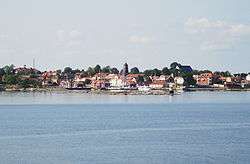Öregrund
| Öregrund | |
|---|---|
|
Öregrund seen from a boat moving between Gräsö and Öregrund | |
 Öregrund  Öregrund | |
| Coordinates: 60°20′N 18°26′E / 60.333°N 18.433°ECoordinates: 60°20′N 18°26′E / 60.333°N 18.433°E | |
| Country | Sweden |
| Province | Uppland |
| County | Uppsala County |
| Municipality | Östhammar Municipality |
| Area[1] | |
| • Total | 2.44 km2 (0.94 sq mi) |
| Population (31 December 2010)[1] | |
| • Total | 1,555 |
| • Density | 636/km2 (1,650/sq mi) |
| Time zone | CET (UTC+1) |
| • Summer (DST) | CEST (UTC+2) |

Öregrund is a locality situated in Östhammar Municipality, Uppsala County, Sweden with 1,555 inhabitants in 2010.[1] It is located by the coast of the Baltic Sea. Öregrund is, despite its small population, for historical reasons often still referred to as a city.
History
The town was granted a royal charter in 1491, by request from citizens from nearby city of Östhammar. Östhammar had once been a coastal town, but due to post-glacial rebound its harbour had become useless. The royal council granted the request to construct a city at the end of the archipelago where the sea opened. It further proclaimed "the city shall forever be known as Öregrund". The small but expanding city soon became a point of conflict. In 1520 Christian II of Denmark conquered Stockholm. A young Gustav Eriksson tried to gather an army, and Öregrund became the port whereto ships with men and weapons were transported. As a countermeasure, the Danish King had the city burnt in the winter of 1520. And so, the citizens of Öregrund had to move back to Östhammar.
Not until 1555, when Gustav Eriksson had become King Gustav I of Sweden (Vasa) and stabilized the nation, were the citizens granted permission to reconstruct the city.
Uppland underwent an industrial revolution in the 17th century, with the Swedish iron industry becoming the foundation of Sweden's status as a Great Power. Bar iron was exported through Öregrund. In England the best quality wrought iron was known as Oregrounds iron.
Fishing was basically the only industry through the centuries. The industrialization of the 19th century never took hold in Öregrund; instead establishing itself in the nearby Östhammar.
In the late 19th century a new industry prospered: the spas. People from outside bought up summer houses and made Öregrund their summer residence. During this era, several fine villas and gardens were built.
However, the summer residents led to decreased tax incomes for economically troubled city. In 1968, Öregrund was merged with the then-city of Östhammar. Since the municipal reform of 1971, Öregrund is in Östhammar Municipality.
Modern times
The nave of Öregrund is still the harbour. In modern times it is mainly used for small boats. In the summer it flourishes due to small sailboats and other pleasure boats. Boats also arrive from Stockholm, taking a trip from the Stockholm Archipelago.
Sights
Öregrund is one of Uppland's best kept wooden cities and attracts many visitors. Apart from the wooden houses, there is also a noteworthy stone church in the town center, and a town hall from the mid 19th century.
References
- 1 2 3 "Tätorternas landareal, folkmängd och invånare per km2 2005 och 2010" (in Swedish). Statistics Sweden. 14 December 2011. Archived from the original on 10 January 2012. Retrieved 10 January 2012.
External links
| Wikimedia Commons has media related to Öregrund. |
- (in Swedish) Allt om Öregrund (in Swedish)
- (in Swedish) article Öregrund from Nordisk familjebok (1922)
- (in Swedish) Öregrund historia private webpage / Stig Sandelin (Summary in English: )
